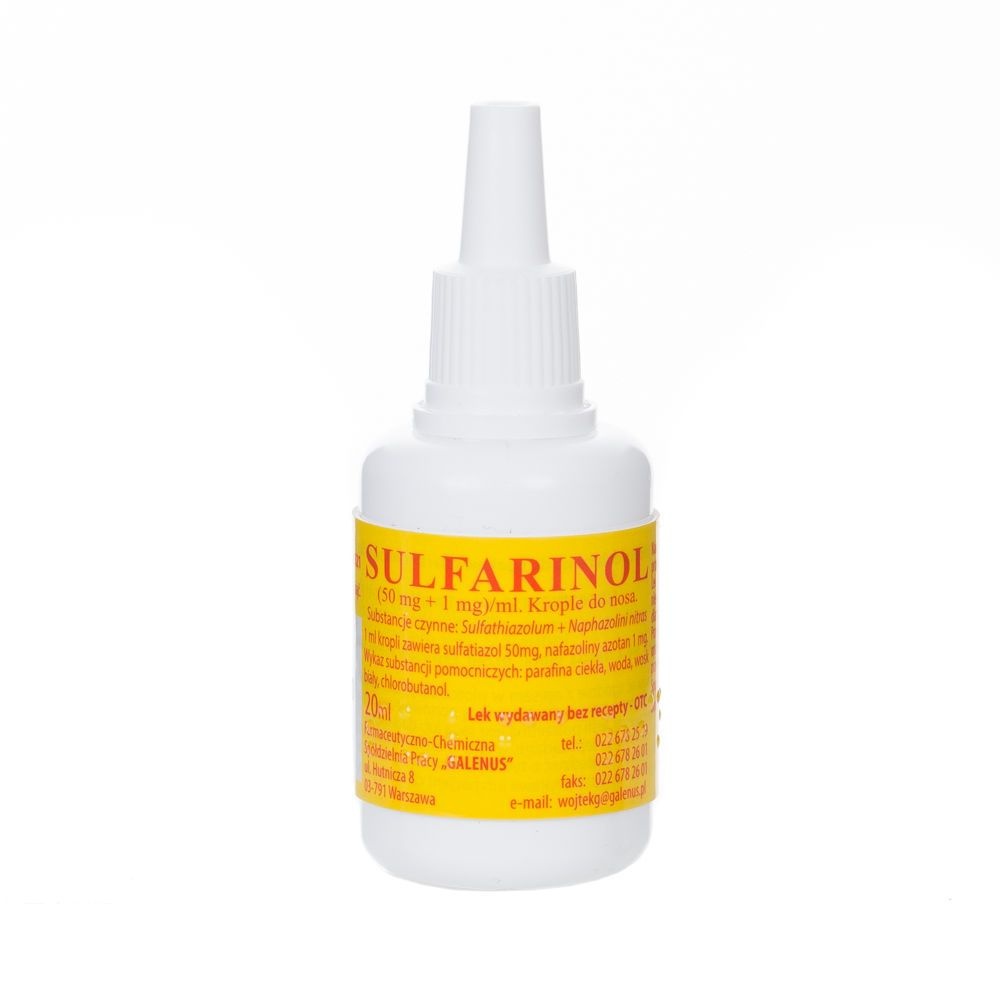

Sulfarinol

Ask a doctor about a prescription for Sulfarinol

How to use Sulfarinol
Package Leaflet: Information for the User
SULFARINOL, (50 mg + 1 mg)/ml, Nasal Drops
Sulfathiazole+ Naphazoline nitrate
Read the package leaflet carefully before using the medicine, as it contains important information for the patient.
This medicine should always be used exactly as described in this package leaflet for the patient, or as directed by a doctor or pharmacist.
- Keep this leaflet, you may need to read it again.
- If you need advice or additional information, consult a pharmacist.
- If the patient experiences any side effects, including any possible side effects not listed in this leaflet, they should inform their doctor or pharmacist. See section 4.
- If there is no improvement after 5 days or the patient feels worse, they should contact their doctor.
Table of Contents of the Leaflet
- 1. What is Sulfarinol and what is it used for
- 2. Important information before using Sulfarinol
- 3. How to use Sulfarinol
- 4. Possible side effects
- 5. How to store Sulfarinol
- 6. Contents of the pack and other information
1. What is Sulfarinol and what is it used for
Sulfarinol nasal drops are a white, oily liquid containing two active substances
- sulfathiazole in an amount of 50 mg/1 ml and naphazoline nitrate in an amount of 1 mg/1 ml. Sulfathiazole is a sulfonamide with a short-acting bacteriostatic effect on Gram-positive and Gram-negative bacteria. Naphazoline is an imidazole derivative with adrenergic activity (stimulating the sympathetic nervous system). Local application to the nasal mucosa causes, after about 5 minutes, constriction of dilated blood vessels, which leads to inhibition of symptoms associated with inflammation, including swelling and discharge (runny nose). This facilitates the removal of discharge from the paranasal sinuses and breathing through the nose. Intranasal administration can also open the Eustachian tube. The drug acts mainly symptomatically. The therapeutic effect lasts 6 to 8 hours. Sulfarinol is used to treat runny nose, feeling of nasal congestion, and swelling of the nasal mucosa caused by inflammation associated with bacterial infection. If there is no improvement after five days or the patient feels worse, they should consult a doctor.
2. Important information before using Sulfarinol
When not to use Sulfarinol
- if the patient is allergic to the active substances or any of the other ingredients of this medicine (listed in section 6)
- if the patient is allergic to sulfonamides;
- if the patient has angle-closure glaucoma;
- if the patient has atrophic rhinitis;
- in children under 12 years of age.
Warnings and precautions
Before starting to use Sulfarinol, the patient should discuss it with their doctor or pharmacist if:
- the patient is being treated with MAO inhibitors or tricyclic antidepressants (drugs used in psychiatry and neurology);
- local pain, lack of improvement, worsening of local mucosal changes, and nasal bleeding occur;
- the patient has diabetes, asthma, hypertension, thyroid disease, cardiovascular disease (especially in cases of rhythm disorders), cerebral arteriosclerosis, prostatic hyperplasia;
- the patient is elderly. The medicine should not be used for more than 5 days. In cases requiring caution and in case of any doubts, before using Sulfarinol, the patient should consult their doctor.
Children and adolescents
Do not use in children under 12 years of age.
Sulfarinol and other medicines
The patient should tell their doctor or pharmacist about all medicines they are currently taking or have recently taken, as well as any medicines they plan to take.
Using medicines containing naphazoline in patients treated with tricyclic antidepressants may enhance their effect on blood vessels (increased constriction).
Concomitant use of MAO inhibitors may lead to a hypertensive crisis (sudden increase in blood pressure).
Using Sulfarinol with food and drink
Sulfarinol can be used at any time, regardless of meals.
Pregnancy, breastfeeding, and fertility
If the patient is pregnant or breastfeeding, thinks they may be pregnant, or plans to have a child, they should consult their doctor or pharmacist before using this medicine.
Sulfarinol should not be used during pregnancy and breastfeeding, unless it is absolutely necessary. The decision can only be made by a doctor after assessing the expected benefit of treatment for the mother in relation to the risk to the fetus or breastfed child.
Driving and using machines
No studies have been conducted on the effect of the product on the ability to drive and use machines. The patient should be cautious and not perform such activities if side effects occur or they are particularly sensitive to the effect of the medicine.
Sulfarinol contains methyl parahydroxybenzoate (E 218) and propyl parahydroxybenzoate (E 216)
1 ml of the medicinal product contains 0.16 mg of methyl parahydroxybenzoate (E 218) and 0.01 mg of propyl parahydroxybenzoate (E 216). The medicine may cause allergic reactions (possible late reactions).
3. How to use Sulfarinol
This medicine should always be used exactly as described in this package leaflet for the patient, or as directed by a doctor or pharmacist. In case of doubts, the patient should consult their doctor or pharmacist.
The recommended dose for adults and children over 12 years of age is 1 to 2 drops every 4 to 6 hours into each nostril. The medicine should be instilled into each nostril on the nasal wing, then the nose should be pinched several times with the index finger and thumb. Shake before use.
The medicine should not be used more frequently than every 4 hours and not for more than 3 to 5 days.
Use in children and adolescents
The use of the medicine in adolescents over 12 years of age is in accordance with the adult dosage.
Sulfarinol should not be used in children under 12 years of age.
Using a higher dose of Sulfarinol than recommended
Using significantly higher doses than recommended may cause general side effects, such as increased blood pressure, nausea, pain, and dizziness, palpitations, drowsiness, and lethargy, slowing of heart rate, and Stevens-Johnson syndrome (fever and severe symptoms in the skin and mucous membranes of the nose and mouth). Significant overdose may lead to inhibition of the central nervous system with severe sedation, hypotension (shock), hypothermia, and coma, as well as sticking of the nasal mucosa cilia. This systemic effect is caused by the flow of excess drops into the stomach and absorption of the medicine into the bloodstream from the gastrointestinal tract. In such a case, the patient should immediately consult a doctor.
Prolonged use of higher doses than recommended for a longer period than recommended (more than 3 to 5 days) may cause permanent damage to the mucosa.
Missing a dose of Sulfarinol
A double dose should not be used to make up for a missed dose.
Stopping the use of Sulfarinol
Stopping the use of Sulfarinol prematurely may result in a lack of therapeutic effect and contribute to the development of resistance of bacterial strains to the medicine.
In case of any further doubts related to the use of this medicine, the patient should consult their doctor or pharmacist.
4. Possible side effects
Like all medicines, Sulfarinol can cause side effects, although not everybody gets them.
Side effects that occur with proper use, as recommended in this leaflet, are very rare. Local side effects - allergic symptoms (skin rash, lip swelling) may occur in case of use (despite contraindications) in people allergic to sulfonamides. General side effects caused by naphazoline nitrate may occur after intranasal administration due to rapid absorption of the medicine through the inflamed mucosa and in case of overdose after incorrect instillation (when the medicine flowing into the stomach is absorbed from the gastrointestinal tract). This may also occur in case of use (despite contraindications) in children, mainly in the age group under 3 years.
- sneezing;
- prickling pain in the nose;
- burning sensation;
- increased nasal discharge;
- allergic reactions. General side effects, most often related to overdose, include:
- increased blood pressure;
- nausea;
- headache and dizziness;
- palpitations;
- drowsiness and lethargy;
- slowing of heart rate;
- Stevens-Johnson syndrome.
Additional side effects in children and adolescents
Local side effects - allergic symptoms (skin rash, lip swelling) may occur in case of use (despite contraindications) in children under 12 years of age, especially in the age group under 7 years.
General side effects caused by naphazoline nitrate may occur after intranasal administration due to rapid absorption of the medicine through the inflamed mucosa and in case of overdose after incorrect instillation (when the medicine flowing into the stomach is absorbed from the gastrointestinal tract). This may also occur in case of use (despite contraindications) in children, mainly in the age group under 3 years.
Reporting side effects
If any side effects occur, including any side effects not listed in this leaflet, the patient should inform their doctor or pharmacist. Side effects can be reported directly to the Department of Monitoring of Adverse Reactions to Medicinal Products of the Office for Registration of Medicinal Products, Medical Devices, and Biocidal Products
Al. Jerozolimskie 181C
PL-02 222 Warsaw
Phone: +48 22 49 21 301
Fax: +48 22 49 21 309
Website: https://smz.ezdrowie.gov.pl
Side effects can also be reported to the marketing authorization holder.
Reporting side effects will allow for more information to be collected on the safety of the medicine.
5. How to store Sulfarinol
The medicine should be stored out of sight and reach of children.
Store in a temperature below 25°C in the original packaging to protect from light.
Do not use this medicine after the expiry date stated on the label. The expiry date refers to the last day of the specified month.
Medicines should not be disposed of via wastewater or household waste containers. The patient should ask their pharmacist how to dispose of medicines that are no longer needed. This will help protect the environment.
6. Contents of the pack and other information
What Sulfarinol contains
- The active substances of the medicine are: sulfathiazole and naphazoline nitrate.
- The other ingredients (excipients) are: liquid paraffin, purified water, white wax, methyl parahydroxybenzoate (E 218), and propyl parahydroxybenzoate (E 216).
What Sulfarinol looks like and what the pack contains
The immediate packaging of the medicine is a polyethylene bottle with a dropper. The bottle contains 20 ml of a white oily liquid.
Marketing authorization holder
TACTICA Pharmaceuticals Sp. z o.o.
ul. Królowej Jadwigi 148a/1a
30-212 Kraków
phone: +48 889 388 538
Manufacturer
Farmaceutyczno-Chemiczna Spółdzielnia Pracy „GALENUS"
ul. Hutnicza 8; 03-791 Warsaw
phone: 022 6796921
phone/fax: 022 6792215
e-mail: [email protected]
Date of last revision of the leaflet:11/2024
- Country of registration
- Active substance
- Prescription requiredNo
- ImporterFarmaceutyczno-Chemiczna Spółdzielnia Pracy GALENUS
- This information is for reference only and does not constitute medical advice. Always consult a licensed doctor before taking any medication. Oladoctor is not responsible for medical decisions based on this content.
- Alternatives to SulfarinolDosage form: Drops, (1 mg + 0.33 mg)/mlActive substance: naphazolineManufacturer: Warszawskie Zakłady Farmaceutyczne POLFA S.A.Prescription not requiredDosage form: Aerosol, (1.5 mg + 2.5 mg)/mlActive substance: phenylephrineManufacturer: Aflofarm Farmacja Polska Sp. z o.o.Prescription not requiredDosage form: Aerosol, (0.05 mg + 5 mg)/doseActive substance: xylometazolineManufacturer: Klosterfrau Berlin GmbHPrescription not required
Alternatives to Sulfarinol in other countries
The best alternatives with the same active ingredient and therapeutic effect.
Alternative to Sulfarinol in Ukraine
Alternative to Sulfarinol in Spain
Online doctors for Sulfarinol
Discuss dosage, side effects, interactions, contraindications, and prescription renewal for Sulfarinol – subject to medical assessment and local rules.








